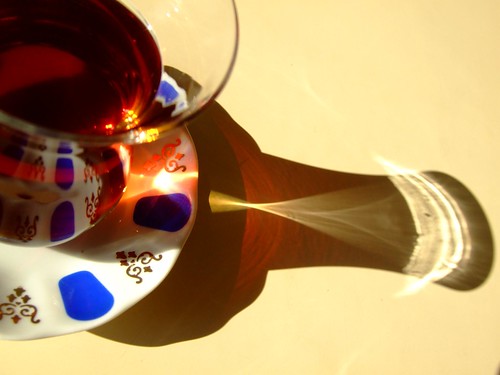We’re serving up a lexicon of libations all week at Wordnik (in honor of Oktoberfest, National Bourbon Heritage Month, and Thursday’s National Coffee Day). Yesterday we poured some wine words; now it’s time for tea.
Tea ceremonies are almost as varied as tea types. In Great Britain, there’s afternoon tea, or low tea, “a small meal eaten between lunch and dinner.” There’s the tea break, “a snack taken during a break in the work day,” and the tea dance, “a late afternoon or early evening dance, typically with a live orchestra (often referred to as a palm court orchestra) playing light classical music.”
There’s the tea party, “a semi-formal afternoon social gathering at which tea, sandwiches and cakes are served,” also written as tea-party and once known as “any disquieting occurrence or happening,” or “something easy to do or accomplish.” There’s Lewis Carroll’s Mad Tea-Party, the Boston Tea Party, and, um, that Tea Party.
JRR Tolkien gave us elevenses, “tea or coffee taken at midmorning and often accompanied by a snack.” Originating from the county of Devon in England is Devonshire or cream tea, “a light afternoon meal consisting of scones, jam and clotted cream served with the drink tea.”
We can’t forget high tea, “a fairly substantial meal that includes tea and is served in the late afternoon or early evening,” also known as meat tea. But as Lynneguist writes:
I’ve never heard a British person use the term [high tea]. They say things like I have to get home and make the children’s tea, by which they mean their evening meal. In my experience, tea, when referring to a meal, is used by my friends mostly to refer to simple meals they make for their children or themselves in the early evening; a dinner party, for example, would not be referred to as tea.
Slang for a cup of tea in British English is cuppa, as well as char, an alternation of the Chinese word for tea, cha.
Yum cha, Cantonese Chinese for “drink tea,” is a traditional Chinese meal of many small dishes and Chinese tea, often partaken late weekend mornings. Yum cha is also known as dim sum in Cantonese and dian xin in Mandarin. Dim sum refers to the small dishes, and translates as “a little bit of heart.” Common yum cha teas include chrysanthemum, jasmine, and oolong, “a variety of black tea with the flavor of green tea.” Oolong translates as “black dragon.”
If you want to get fancy, brew some gunpowder tea, a green tea in which each leaf is rolled into a pellet; or longjing, dragon well tea, another type of green tea. Of the black tea variety (black teas are referred to as hong cha, literally “red tea,” in Chinese) try some souchong, pouchong, or congou. Congou comes from the Amoy or Xiamen Chinese dialect and means “elaborately prepared (tea),” and corresponds to the Mandarin Chinese gōngfu (chá), “worksmanship (tea),” a different gōngfu, by the way, than the martial art, as explained by Victor Mair at Language Log.
Or you may want to try ba bao cha, which translates from Mandarin as “eight treasure tea.” Eight is the number of ingredients – “goji berries, jujube (a type of red date,) dried citrus peel, dried ginseng root, rock sugar crystals, dried chrysanthemum flowers, green tea, and dried longan fruit” – and is an auspicious number in Chinese culture. Eight or ba is a homonym of the word for prosperity (the number four, si, is a homonym for the word for death, and therefore a very unlucky number).
The Japanese tea ceremony is known as the Way of Tea, translated from the Japanese, chado, with cha meaning “tea” and do – sometimes spelled tao – meaning “the way”; and as chanoyu, translating roughly as “tea of hot water.” The ceremony involves the ritual preparation and presentation of matcha, a powdered green tea.
Another green tea is sencha, which differs from matcha in that the leaves are not ground. Shincha is “the first month’s harvest of Sencha,” while bancha is the second harvest of sencha. Gyokura is an expensive green tea that differs from sencha in that “it is grown under the shade rather than the full sun.” On the other hand, genmaicha, a green tea combined with roasted brown rice, “was originally drunk by poor Japanese, as the rice served as a filler and reduced the price of the tea.” Genmaicha is also known as popcorn tea and people’s tea (and is this blogger’s personal favorite).
Central to tea life in Russia, parts of Europe, the Middle-East, northern China, and elsewhere is the samovar. Translated as “self boiling,” the samovar is “a copper urn. . .in which water is kept boiling for use when required for making tea, live charcoal being placed in a tube which passes up through the center of the urn.” The tea concentrate is called zavarka, while the boiled water is kipyatok. Tea the beverage is referred to as chai (also “a beverage made with black teas, steamed milk and sweet spices based loosely on Indian recipes”). The chainik is “a teapot with a spout for making zavarka,” and also means “incapable dummy” in Russian slang. For even more on Russian tea, check out this excellent source.
As for tea culture in the United States, one could argue that it surrounds iced tea. Or is it ice tea? Mark Liberman at Language Log tries to figure it out. Variations of iced tea include sun tea, “a beverage, often iced, made from tea leaves or other herbs steeped in water exposed to direct sunlight”; sweet-tea; and Thai iced tea, also known as cha-yen.
Finally, for tea types, lingo, and paraphernalia, be sure to check out our list of the day.
Tomorrow we take a look at funny drink names. Get your tiny umbrellas ready!
[Photo: CC BY-SA 2.0 by marfis75]


